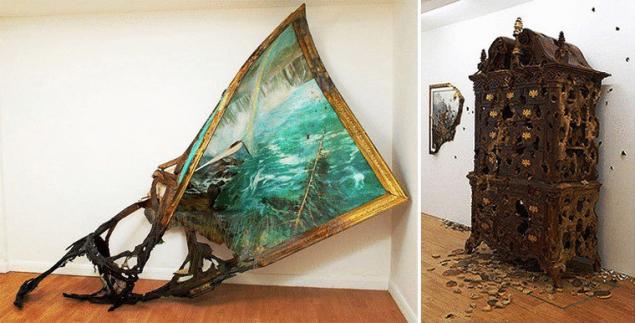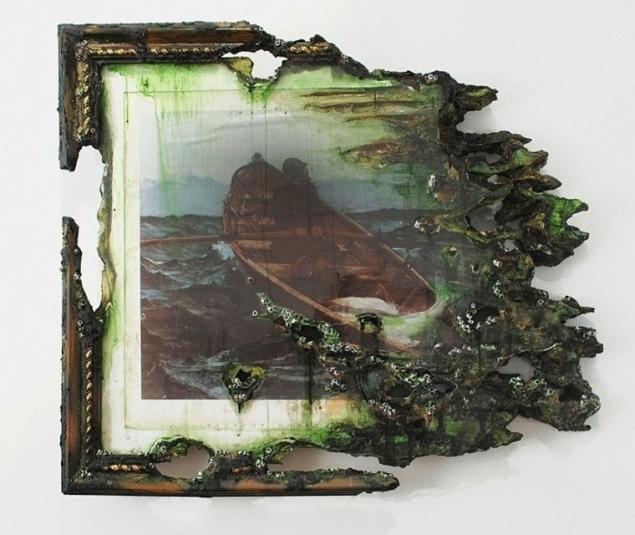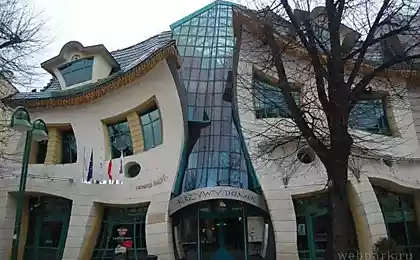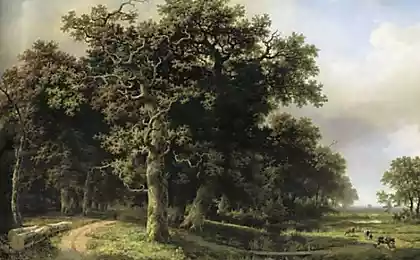542
A series of deformed paintings
Imagine: you walk into the showroom, and there I see a strange pattern: some like after the flood, others burnt, and still others cracked... This is the work of American artist and sculptor Valerie Hegarty. She did a whole series of these strain of paintings titled "Altered States" ("Altered States").

First, as a basis for their work Valerie took copies are easily recognizable paintings by American artists, representatives of "abstract expressionism" hudojnikov colonial era: albert Bierstadt, clyfford still, mark Rothko (Albert Bierstadt, Clyfford Still, Mark Rothko), and purposely gave them a look, as though they suffered from the elements. For example, if it is a Marina, though she is damaged by water, if landscape, then it can be trace as though from a fire... At first creativity she was interested in the process of destruction of the paintings and the changes to them during disruption.

During the creation (or the destruction) of his work, Valerie turns well-known paintings by American artists, in separate works, much survived, and the last "water, fire, and woodpeckers". She says that your paintings aims to show what the artists of the XIX century were silent. They are often depicted pastoral scenes, to avoid the theme of the destructive power of nature. Hegarty pulls them pictures of familiar historical context, and deforming them, making their paintings with their own biography, their own meaning. Thus, it forces the viewer to ask: where is this picture? What happened to her?


Hegarty's work is filled with both irony and a kind of patriotism. This talented girl proves that works of art can be born not only by creation, but in the process of destruction. As the raging element awakens in us the instinctive emotions, a mixture of admiration and fear and when you look at these pictures viewers vaguely felt the same way. And the response in their hearts -the best reward for Valerie.

Source: /users/104

First, as a basis for their work Valerie took copies are easily recognizable paintings by American artists, representatives of "abstract expressionism" hudojnikov colonial era: albert Bierstadt, clyfford still, mark Rothko (Albert Bierstadt, Clyfford Still, Mark Rothko), and purposely gave them a look, as though they suffered from the elements. For example, if it is a Marina, though she is damaged by water, if landscape, then it can be trace as though from a fire... At first creativity she was interested in the process of destruction of the paintings and the changes to them during disruption.

During the creation (or the destruction) of his work, Valerie turns well-known paintings by American artists, in separate works, much survived, and the last "water, fire, and woodpeckers". She says that your paintings aims to show what the artists of the XIX century were silent. They are often depicted pastoral scenes, to avoid the theme of the destructive power of nature. Hegarty pulls them pictures of familiar historical context, and deforming them, making their paintings with their own biography, their own meaning. Thus, it forces the viewer to ask: where is this picture? What happened to her?


Hegarty's work is filled with both irony and a kind of patriotism. This talented girl proves that works of art can be born not only by creation, but in the process of destruction. As the raging element awakens in us the instinctive emotions, a mixture of admiration and fear and when you look at these pictures viewers vaguely felt the same way. And the response in their hearts -the best reward for Valerie.

Source: /users/104























